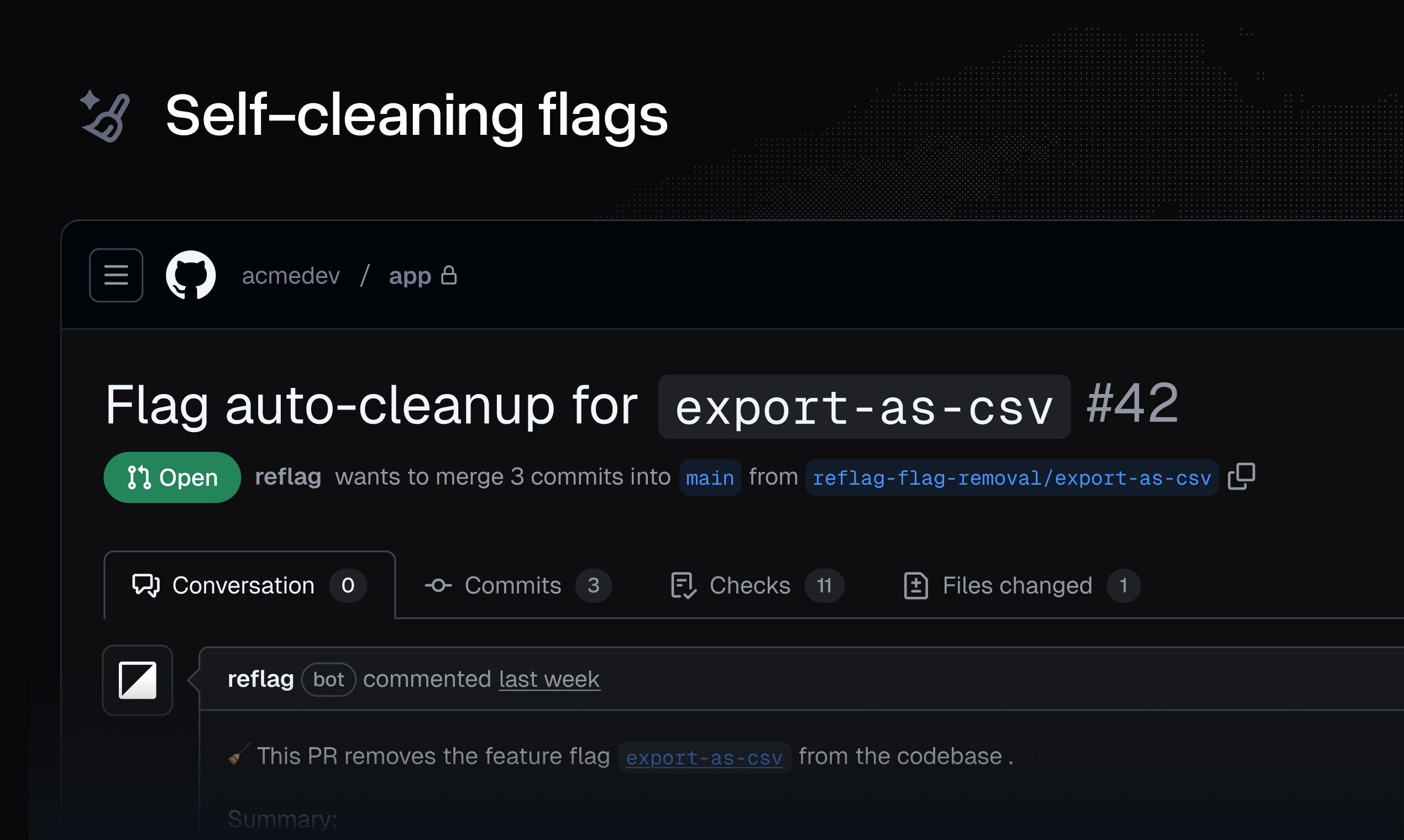Table of Contents
Overview
In the dynamic landscape of SaaS development, managing feature rollouts, beta programs, and A/B testing presents complex challenges. Reflag emerges as a powerful solution, offering feature flags specifically designed for SaaS applications built on TypeScript. As the first-ever platform with self-cleaning flags that automatically generate pull requests to remove stale flag code, Reflag ensures your codebase remains clean and efficient. Built with strong type-safety, comprehensive support for beta programs, and seamless integration with development tools like Linear and Slack, Reflag streamlines your development and release cycles while reducing technical debt.
Key Features
Reflag delivers comprehensive functionality designed to give developers and product teams precise control over their feature releases.
- Early Access/Beta Gating: Effortlessly manage access to new features for specific user groups, making it ideal for beta programs and early access initiatives
- Exposure and Adoption Monitoring: Gain crucial insights into feature usage patterns, tracking both exposure rates and adoption metrics directly from an intuitive dashboard
- In-App Feedback Capture: Collect valuable user feedback directly within your application, enabling rapid iteration and improvement based on real-world usage data
- TypeScript-First SDKs and React Hook: Experience developer-friendly workflows with strongly-typed feature checks through TypeScript-first SDKs and the intuitive useFlag React hook
- AI-Powered Code Cleanup: Revolutionary self-cleaning flags automatically create GitHub pull requests to remove stale feature flag code, maintaining a clean codebase without manual intervention
How It Works
Getting started with Reflag integrates seamlessly into your TypeScript-based SaaS application workflow. Implementation begins by wrapping your application with the ReflagProvider, which requires publishableKey, company, and user parameters for initialization. Once configured, you can utilize the useFlag(“feature”) hook within your components to gate specific UI elements or functionalities. The Reflag dashboard provides real-time control over user cohort targeting, percentage rollouts, and comprehensive monitoring of feature exposure and adoption metrics, delivering complete control over your release strategy.
Use Cases
Reflag addresses critical scenarios in modern SaaS development workflows.
- Rolling Out Betas and Early Access: Seamlessly manage and control access to new features for beta testers and early access users, ensuring controlled and measurable rollouts
- Percentage Rollouts and Advanced Targeting: Implement gradual feature rollouts to specific percentages of your user base, including anonymous users, with precise cohort targeting for tailored user experiences
- Feature Adoption Tracking and Feedback Collection: Monitor feature adoption effectiveness and gather direct in-app feedback to inform data-driven development decisions and product improvements
Pros \& Cons
Advantages
Reflag offers compelling benefits for modern SaaS development teams.
- TypeScript-First Developer Experience: Delivers superior developer experience with strongly-typed SDKs, ensuring robust and error-free feature flag implementation
- Intuitive Integration: Features easy-to-use SDKs that simplify feature flag integration and management within applications
- Built-in Analytics and Tracking: Comes with integrated tools for monitoring feature exposure, adoption rates, and user engagement metrics
- SaaS-Optimized Design: Specifically engineered to meet the unique demands of SaaS product rollouts and beta program management
- Revolutionary Self-Cleaning Technology: Industry-first automatic code cleanup reduces technical debt and maintains codebase quality
Disadvantages
While powerful, Reflag presents several considerations for potential users.
- TypeScript Ecosystem Limitation: Exclusively designed for TypeScript applications, which may exclude teams using other technology stacks
- MTU-Based Billing Complexity: The Monthly Tracked Users billing model requires careful monitoring and planning as usage scales, potentially adding operational overhead
- Relatively New Market Presence: As a newer platform, it has a smaller user community compared to established competitors, which may impact support resources and third-party integrations
How Does It Compare?
Reflag positions itself strategically against established feature flag management platforms in 2025. The competitive landscape includes several major players, each with distinct strengths and positioning.
Enterprise Leaders: LaunchDarkly remains the enterprise standard with comprehensive features but comes with high pricing that can reach thousands of dollars monthly for larger teams. PostHog offers an all-in-one product analytics platform but charges per flag request, making it expensive for high-traffic applications.
Specialized Competitors: Split.io excels in experimentation and A/B testing but focuses primarily on enterprise customers with premium pricing. Flagsmith provides open-source flexibility with both cloud and self-hosted options, making it attractive for teams wanting more control. Unleash offers robust open-source feature flagging with enterprise features but requires more technical setup expertise.
Modern Alternatives: Statsig provides unlimited feature flags with competitive pricing and warehouse-native architecture. FeatBit offers cost-effective solutions with transparent pricing models. ConfigCat provides simple, developer-friendly feature flag management at competitive rates.
Reflag differentiates itself through its TypeScript-first approach, innovative self-cleaning flags technology, and SaaS-specific optimizations. While competitors offer robust general-purpose feature flagging, Reflag’s unique combination of automated code cleanup, strong typing, and SaaS-focused design provides a more tailored solution for modern TypeScript-based development teams seeking to minimize technical debt while maintaining rapid development velocity.
Final Thoughts
Reflag represents an innovative approach to feature flag management, particularly valuable for TypeScript-based SaaS applications. Its focus on strong type-safety, exceptional developer experience, and the groundbreaking self-cleaning flags feature addresses critical pain points in the development lifecycle that traditional solutions often overlook. While the MTU-based billing model requires strategic planning for scaling organizations, the benefits of automated code cleanup, streamlined rollouts, comprehensive monitoring, and integrated feedback loops position Reflag as a compelling choice for development teams prioritizing code quality and rapid iteration. The platform’s TypeScript-first philosophy and SaaS-specific optimizations make it especially attractive for modern development teams seeking to enhance their feature release strategies while maintaining clean, maintainable codebases.
